Bonsai tree care with meditation is more than just keeping a miniature tree alive. The secret to turning bonsai care into a daily mindfulness ritual. It’s care can be a meditative practice, fostering peace and mindfulness alongside and care of your miniature tree.
It’s a simple daily practice of Meditation that can slow your mind, ease stress, and reconnect you with nature in a world that moves too fast.
By engaging in mindful observation, deliberate actions like pruning and watering, and cultivating a connection with the tree’s life force, you can find solace and tranquility in the present moment.
Imagine sitting quietly with a Ficus or Chinese Elm, feeling the rough bark under your fingertips, breathing in the scent of fresh akadama soil, and listening to water soak through the roots.
Each step from pruning fine twigs, gently wiring branches, or refreshing the soil becomes an act of mindful observation rooted in the principles of wabi-sabi and Zen Buddhism.
These traditions, passed down from ancient penjing gardens to today’s bonsai tables, teach patience, presence, and non-attachment. By combining Zazen-inspired breathing with the art of shaping your tree, you create a living reflection of balance: the bonsai grows in form and beauty, while you grow in calm and clarity. This approach is not just for beginner bonsai lovers interested in gardening, and it’s an everyday solution for finding stillness in the middle of life’s noise.
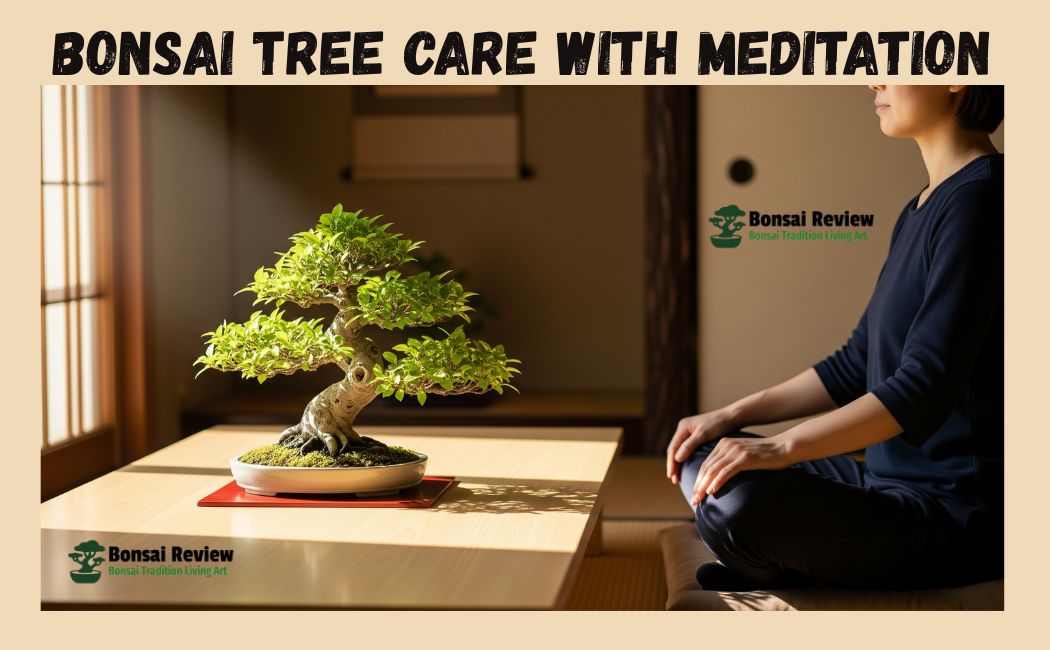
How Can Bonsai Tree Care Help You Reduce Stress and Practice Meditation?
Bonsai tree care with meditation can be a meditative and therapeutic practice, fostering mindfulness and tranquility. The act of tending to a bonsai, from pruning and wiring to watering and observing, can be a form of active meditation, encouraging presence and focus in the present moment. This mindful approach can reduce stress, enhance appreciation for nature, and promote overall well-being. Here’s how bonsai care can be intertwined with meditation:
- Mindful Observation: Spend time simply observing the bonsai, noticing its details, textures, and shape. This focused attention enhances mindfulness and presence.
- Breathing Exercises: Incorporate deep, slow breathing while tending to the tree. This synchronizes your breath with the tree’s energy, promoting relaxation.
- Intentional Actions: Approach each task, like watering or pruning, with intention and focus. This transforms mundane tasks into meditative practices.
- Mindful Shaping: The act of shaping and pruning a bonsai, a deliberate and precise process, requires patience and focus, mirroring the principles of meditation.
- Connecting with Nature: Bonsai care fosters a deep connection with nature, allowing you to slow down, appreciate natural cycles, and develop a more sustainable approach to life.
By integrating these practices, bonsai care can become a powerful tool for cultivating inner peace, reducing stress, and deepening your connection with both yourself and the natural world.
Why Bonsai and Meditation Belong Together?
Bonsai tree care with meditation shares the same heart, patience, focus, and presence. In bonsai care, every step is slow and intentional, just like in meditation. You cannot rush the shaping of a tree any more than you can rush inner calm. Both require you to pause, breathe, and notice the small details that often go unseen in daily life.
Culturally, bonsai has long been tied to mindfulness. In Japan, tending a bonsai is seen as an art form and a spiritual practice, much like Zen meditation. The act of pruning, wiring, and watering mirrors the process of clearing the mind, removing clutter, shaping thoughts, and creating balance.
In modern life, where constant noise and speed dominate, combining these two practices creates a natural retreat. Your bonsai becomes your meditation partner, grounding you in the present moment. The tree teaches patience; meditation helps you appreciate its lessons.
Together, they form a cycle, and the more you care for your bonsai, the calmer you feel, and the calmer you feel, the better you care for your bonsai.
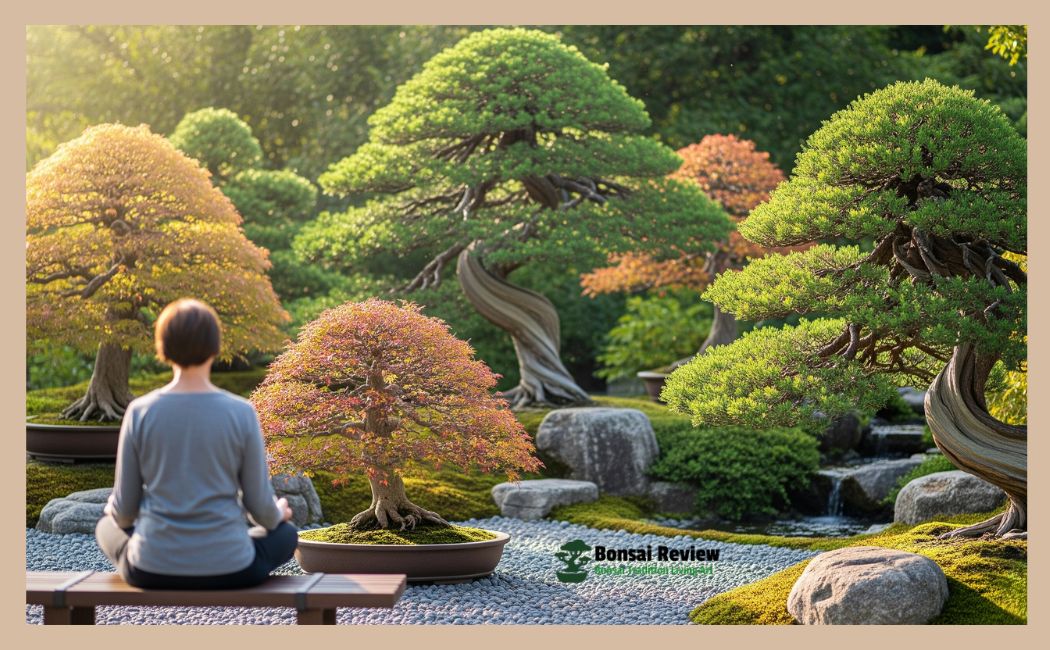
How Does Bonsai Tree Care with Meditation Benefit Your Mind and Body?
When you combine bonsai care with meditation, you’re not just looking after a tree; you’re also nurturing your well-being.
Science shows that mindful activities lower stress hormones like cortisol, improve focus, and even help regulate blood pressure.
The slow, deliberate actions of pruning, wiring, or watering naturally activate your parasympathetic nervous system, the part of your body responsible for relaxation.
Bonsai care also improves mental clarity. When you direct your full attention to the fine details, the curve of a branch, the way light falls on fresh leaves, you train your brain to stay present. Over time, this strengthens concentration and reduces anxiety.
On a deeper level, you’ll find emotional benefits. Your bonsai becomes a living symbol of patience, resilience, and harmony.
Watching it grow reminds you that progress takes time and that beauty often comes from small, steady steps. This is why bonsai has been linked to Zen and mindfulness traditions for centuries; it offers a quiet path to inner peace while keeping you connected to nature’s rhythms.
Common Stress Triggers: How Bonsai Tree Care with Meditation Helps?
Life today is full of small, constant stress triggers, deadlines, phone notifications, and mental overload. Bonsai Tree Care with Meditation: How to Grow Peace Alongside Your Tree? These keep your mind restless and your body tense.
If left unchecked, stress can show up as headaches, poor sleep, irritability, or even a lack of creativity. Here’s where bonsai meditation becomes a simple but powerful solution.
1. Problem: Mental Clutter and Overthinking
- The Trigger: Endless thoughts racing through your mind, making it hard to focus.
- The Solution: Mindful bonsai observation. Spend five minutes looking closely at your bonsai’s leaves, bark texture, and branch patterns. This sensory focus naturally slows down mental chatter.
2. Problem: Anxiety and Restlessness
- The Trigger: Feeling on edge or impatient throughout the day.
- The Solution: Breathwork while watering. As you slowly pour water, match the flow to your breathing. Inhale as you lift the watering can, exhale as the water touches the soil. This rhythmic act signals the body to relax.
3. Problem: Lack of Emotional Balance
- The Trigger: Mood swings or feeling drained after social or work interactions.
- The Solution: Pruning with intention. Each cut becomes a symbolic release of negativity. Saying a positive affirmation with each snip reinforces emotional grounding.
4. Problem: Creative Block
- The Trigger: Struggling to generate new ideas or feeling uninspired.
- The Solution: Shape your bonsai as a meditative design session. Thinking about balance, symmetry, and flow while working on your tree stimulates creative thinking in a calm, pressure-free space.
By turning bonsai care into a mindful meditation practice, you transform daily stress into moments of stillness, clarity, and renewed energy. The problems that once pulled you away from peace become the very reasons you sit down with your dwarf tree indoors.
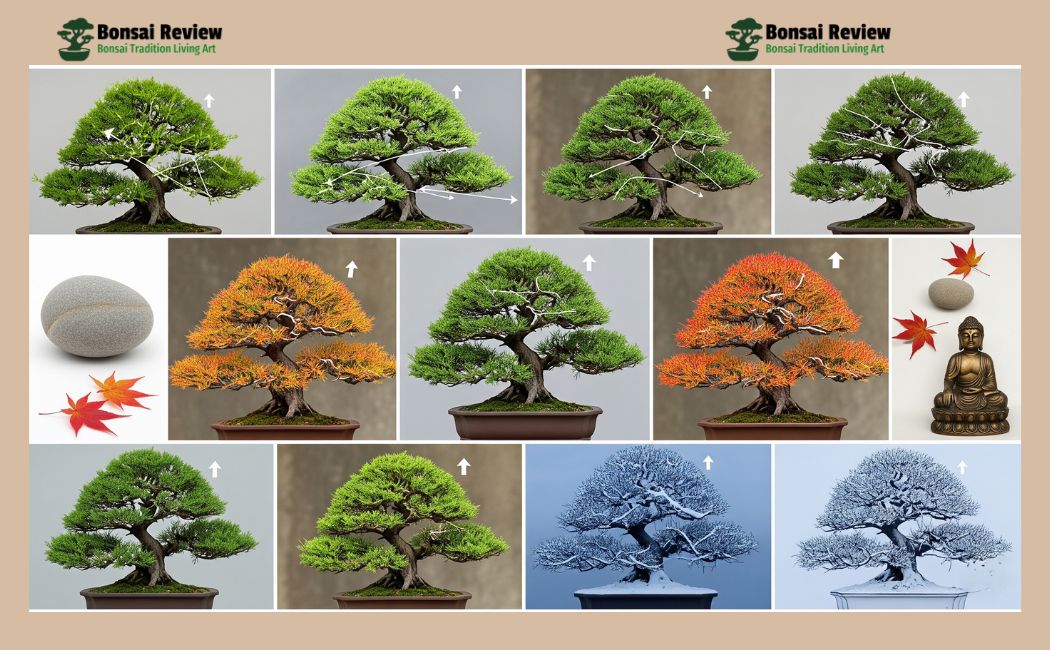
5 Step-by-Step Guide to Practicing Bonsai Meditation.
This is where you bring bonsai tree care with meditation together into one calming ritual. Follow these steps daily or weekly to build a habit that feeds both your tiny indoor plant and your peace of mind.
1. Prepare Your Space: Bonsai Tree Care with Meditation Decor.
Choose a quiet spot with natural light. Place your bonsai where you can sit comfortably at eye level. Keep tools like pruning scissors, a watering can, and a small cloth within reach. This setup signals your brain that it’s time to slow down.
2. Start with Stillness.
Before touching your tree, close your eyes and take three slow breaths. Imagine you’re grounding yourself like the bonsai’s roots, steady, anchored, and present.
3. Observe Without Action.
Look at your bonsai carefully. Notice the texture of the bark, the color of the leaves, and the curve of each branch. This trains your attention to focus on the present moment rather than wandering thoughts.
4. Care with Awareness
When you water, prune, or clean leaves, move slowly. Feel the weight of the watering can, hear the trickle of water, and notice how the leaves respond to your touch. Each action becomes a mindful movement.
5. End with Gratitude: Bonsai Tree Care with Meditation Can Provide Stress Relief.
When your care session is done, place your hands gently on your lap, close your eyes, and thank your bonsai for the peace it brings. This small act seals the practice and leaves you with a calm, uplifted mood.
Done regularly, bonsai tree care with meditation, these steps turn bonsai maintenance into a personal mindfulness retreat, no meditation cushion or incense required. You’re simply present, one breath and one leaf at a time.
Choosing the Right Bonsai for Your Meditation Practice
Picking the right bonsai tree is key to making your care routine feel calm and rewarding, not frustrating. Different species need different levels of care, so matching the tree to your environment and experience will help keep your meditation practice peaceful.
1. Bonsai Tree Care with Meditation: Indoor or Outdoor?
If you want to meditate inside, choose indoor-friendly species like Ficus, Jade, or Schefflera. They tolerate lower light and warmer temperatures, making it easier to care for them while focusing on mindfulness.
Outdoor bonsai like Chinese Elm, Juniper, or Japanese Maple need more sunlight and seasonal changes, which can be rewarding if you enjoy nature’s cycles and want to connect deeply with the seasons.
2. Beginner-Friendly Species
Start with trees that forgive small mistakes. Ficus is popular for beginners because it adapts well and requires less pruning. Chinese Elm is also resilient and responds well to shaping. These beginner-friendly bonsai-loving species let you focus more on your meditation practice rather than worry about complex care.
3. Pot and Soil Matter: Bonsai Tree Care with Meditation Impacts.
Choose a traditional unglazed bonsai pot that allows air and water to flow well. Use well-draining soil mixes like akadama, pumice, and lava rock to keep roots healthy. Healthy roots mean a healthy tree and less stress for you.
By selecting a bonsai that fits your space and skill level, you set yourself up for a harmonious blend of care and meditation. This makes each session feel less like a chore and more like a moment of peace.
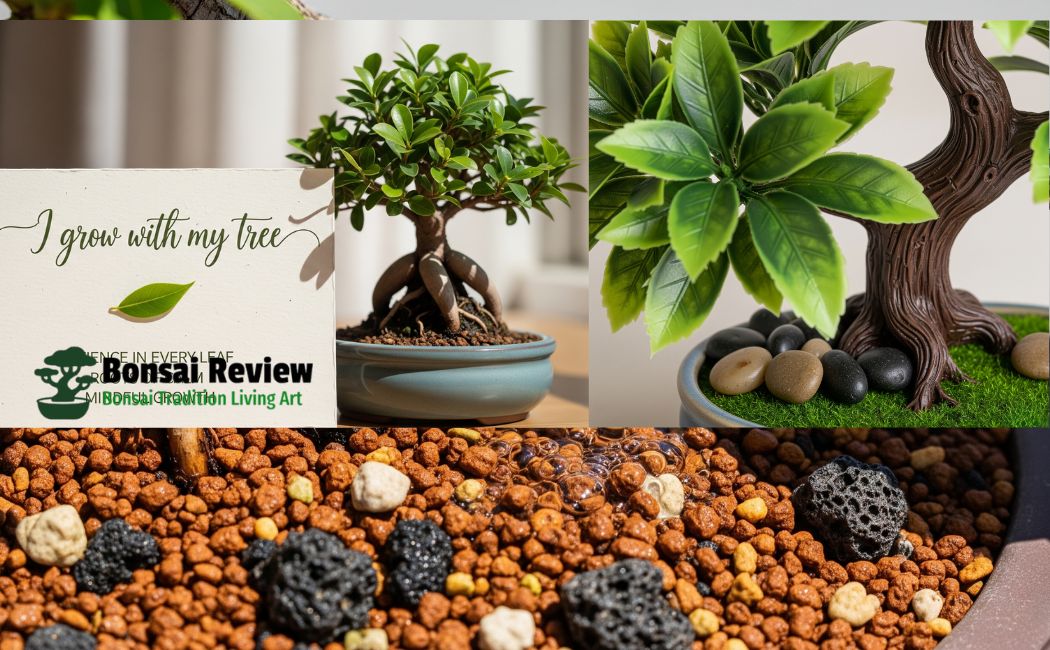
Basic Bonsai Care Tips for a Mindful Practice
Taking care of your bonsai doesn’t have to be complicated. When you treat each care step as part of your meditation, even routine tasks become moments of calm and focus.
1. Watering with Awareness
Check the soil daily. Use your fingers to feel if it’s dry about an inch below the surface. Water slowly and evenly, listening to the sound of water soaking in. Avoid overwatering, which can harm roots and cause stress for both you and your bonsai.
2. Pruning with Intention
Use sharp pruning shears to trim new shoots or dead leaves. Each cut should be deliberate and gentle. This helps shape the tree and keeps it healthy. Focus fully on this task, and it’s a chance to practice patience and precision.
3. Wiring to Shape
When wiring branches, wrap gently to guide growth without damaging bark. Move slowly and notice the tree’s response. Wiring is like a conversation between you and your bonsai, teaching care and respect.
4. Repotting Seasonally
Repot your bonsai every 1-3 years to refresh the soil and trim roots. This is best done in early spring before new growth starts. Use this time to connect deeply with your bonsai’s health and energy.
5. Sunlight and Environment
Place outdoor bonsai where they get plenty of light but are protected from harsh midday sun. Indoor bonsai need bright, indirect light. Adjust placement seasonally to mimic natural conditions.
By incorporating these simple care tips into your meditation, you deepen your connection to the bonsai and establish a soothing daily routine that benefits both the plant and your mind.
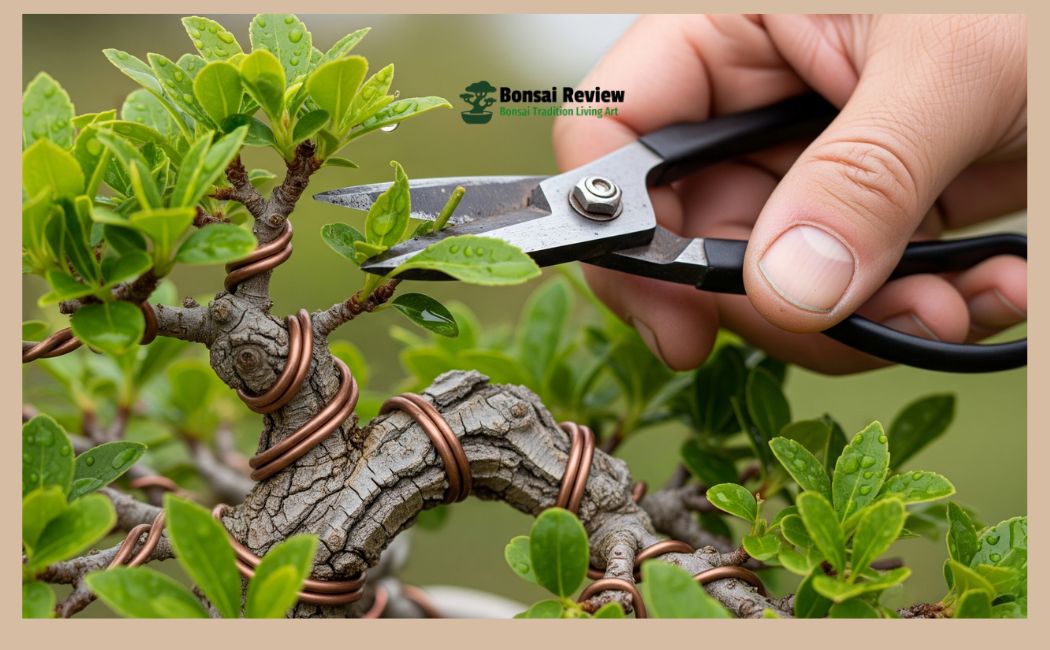
Common Bonsai Care Mistakes and How to Avoid Them?
Struggling to Relax? Try These Simple Bonsai Tree Care with Meditation Techniques.
| Common Mistake | Why It’s a Problem? | How to Avoid It? |
| Overwatering | Causes root rot and stress for the tree | Check soil moisture regularly; water only when the top inch feels dry. |
| Using the Wrong Soil | Poor drainage can suffocate roots | Use well-draining bonsai soil mixes like akadama, pumice, and lava rock. |
| Pruning Too Much or Too Little | Over-pruning weakens the tree; under-pruning affects shape | Practice proper pruning timing and techniques; prune gradually and with intention. |
| Wiring Too Tightly or Too Long | Can damage bark and restrict growth | Wire gently and remove the wiring after a few months to prevent scarring. |
| Ignoring Light Requirements | Insufficient light leads to weak growth and leaf loss | Provide adequate natural or artificial light based on species needs; adjust seasonally. |
| Neglecting Seasonal Care | Trees need rest and protection during dormancy | Protect bonsai in winter; reduce watering and fertilizing during dormancy periods. |
| Rushing Care Steps | Hurried actions reduce mindfulness and may harm the tree | Slow down, breathe deeply, and focus on each task as part of your meditation practice. |
| Using Dull or Dirty Tools | Can cause jagged cuts and infections | Keep pruning tools sharp and clean to promote healthy healing. |
This table highlights key problems beginners often face and gives straightforward solutions to keep bonsai care mindful, healthy, and stress-free.
Long-Term Benefits of Combining Bonsai Care with Meditation
When you make bonsai care part of your meditation routine, the benefits grow deeper over time, just like your tree. This practice supports your mind, body, and spirit in lasting ways.
Mental and Emotional Benefits;
- Stress Reduction: Regular mindful care lowers cortisol levels and calms your nervous system, easing anxiety and tension.
- Enhanced Focus and Patience: Pruning and wiring train your attention, improving concentration both during and outside bonsai sessions.
- Emotional Balance: The slow, deliberate nurturing of your bonsai fosters resilience and helps regulate mood swings.
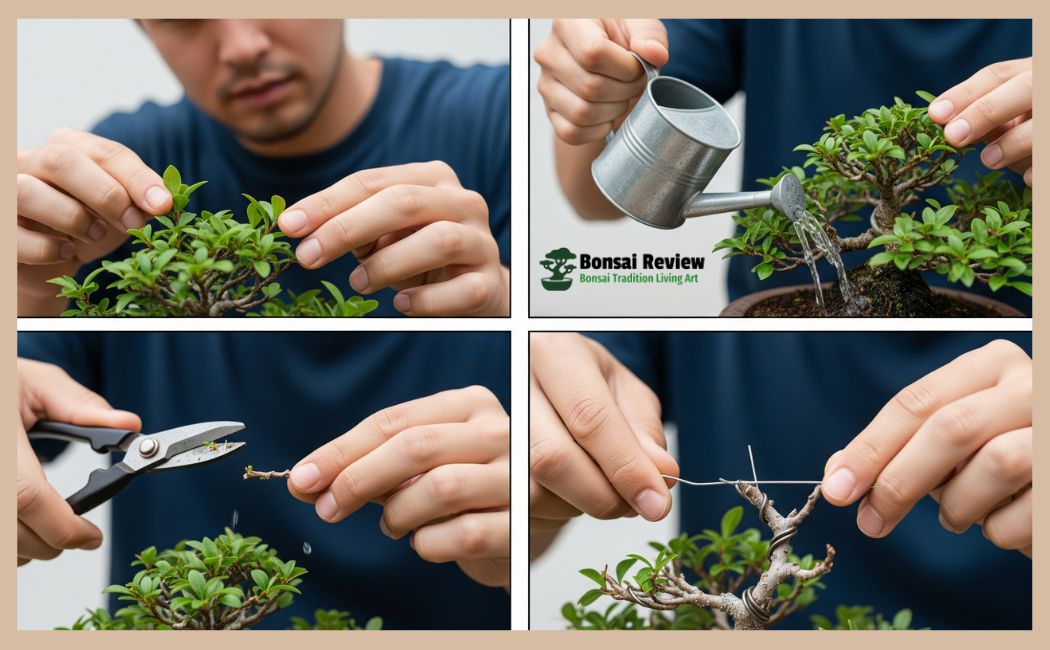
Physical Health Benefits;
- Lower Blood Pressure: Breathing exercises integrated with bonsai care encourage relaxation responses in your body.
- Improved Motor Skills: Fine hand movements involved in wiring and pruning enhance dexterity and coordination.
Spiritual and Philosophical Growth;
- Connection to Nature: Caring for bonsai rooted in wabi-sabi and Zen Buddhism deepens your appreciation of impermanence and simplicity.
- Mindfulness Practice: The blend of Zazen-inspired meditation and bonsai shaping promotes ongoing presence and non-attachment.
- Patience and Acceptance: Observing your bonsai’s slow growth teaches acceptance of life’s natural rhythms and imperfections.
By regularly integrating these mindful bonsai care habits, you cultivate a balanced lifestyle where your inner calm grows hand in hand with your miniature tree’s beauty.
How to Integrate Meditation into Your Bonsai Care Routine?
Caring for a bonsai is more than watering and trimming; it’s a chance to step into stillness, guided by the quiet principles of wabi-sabi and the mindful discipline of Zen Buddhism.
By approaching each task with presence and intention, you turn ordinary dwarf plant care into a Zazen-inspired ritual that nurtures both the tree and your mind.
1. Mindful Observation: Bonsai Tree Care with Meditation
Before you touch your Ficus, Chinese Elm, or Juniper, pause and simply look. Notice the shape of the leaves, the fine lines in the bark texture, and how the light and shadow move across its branches.
Engage all your senses: see the soft greens, feel the smooth ceramic of the bonsai pot, smell the earthy akadama soil, and, if outdoors, listen for the faint sound of wind passing through the foliage.
This sensory immersion helps you anchor in the present moment, just as a Zen monk might do in a temple penjing garden.
2. Deliberate Actions With Bonsai Tree Care with Meditation in Daily Life.
Every movement in bonsai care can mirror your breath. As you prune, take slow, deep inhales and exhales, letting each cut serve the tree’s health and form.
When wiring branches, do it gently, aware of both the tree’s strength and fragility. Check soil moisture carefully, adjusting watering to avoid both drought and overwatering, a balance that reflects the bonsai aesthetic principle of harmony.
Feel the traditional living art connection between your hands and the dwarf tree’s life force in these moments, and you’re not just a caretaker, but a partner in growth.
3. Cultivating Peace: Feel Bonsai Tree Care with Meditation
As you shape, trim, and tend your bonsai, allow the quiet repetition to draw you deeper into the present. Let the process teach patience, perseverance, and acceptance of slow change. You might even repeat a soft affirmation, “I grow with my tree,” as you work.
Over time, this practice becomes both meditative and restorative, offering a daily reminder that care for your bonsai mirrors care for your inner balance.
By blending these mindful steps with traditional bonsai cultivation and care, you create more than a healthy miniature tree. You craft a living meditation that fosters personal growth, stress relief, and a lasting connection with nature.
Conclusion: Growing Calm and Clarity Through Bonsai Meditation
Bonsai tree care with meditation offers you a unique way to slow down and find peace in today’s busy world.
By blending the ancient art of bonsai, rooted in wabi-sabi and Zen Buddhism, with mindful traditions like penjing. With simple, deliberate meditation practices, you transform everyday tasks into moments of calm and focus.
As you prune, water, and shape your bonsai with intention, you’re not just cultivating a miniature tree. You’re nurturing patience, presence, and emotional balance within yourself. This mindful ritual becomes a daily invitation to connect with nature, reduce stress, and embrace life’s natural rhythms.
Both your bonsai and your inner calm grow slowly but steadily. Start small, be patient, and allow this meditative journey to unfold naturally. In caring for your bonsai, you cultivate a lasting wellspring of peace that stays with you long after each session ends.
Helpful article: What Are the Best Indoor Zen Garden Apartment Decor Ideas for Tiny Spaces?
FAQs: Why Bonsai Tree Care Is the Perfect Meditation Practice for Busy People?
1. What is the philosophy behind bonsai?
In traditional Japanese philosophy, wabi-sabi (侘び寂び) is a worldview that embraces the acceptance of impermanence and imperfection. It appreciates beauty that is inherently “imperfect, impermanent, and incomplete” in nature.
2. Is bonsai tree care really a form of meditation?
Yes. When you practice mindful observation, intentional pruning, and slow, focused watering, bonsai care becomes a meditative act. It helps you stay present, calm your mind, and connect deeply with nature, much like traditional Zen or Zazen meditation.
3. What is the Buddhist Form of Meditation?
Anapanasati, mindfulness of breathing, is a core meditation practice in Theravada, Tiantai, and Chan traditions of Buddhism as well as a part of many mindfulness programs. In both ancient and modern times, anapanasati by itself is likely the most widely used Buddhist method for contemplating bodily phenomena.
4. Which bonsai species are best for beginners interested in meditation?
Beginner-friendly species include Ficus, Chinese Elm, Juniper, and Jade. These trees are resilient and adapt well to indoor or outdoor dwarf plant settings, making it easier to focus on mindfulness rather than complicated care.
5. How often should I water my bonsai during meditation practice?
Watering depends on species and environment, but generally, check the akadama or soil daily by touch. Water slowly and mindfully when the top inch feels dry to avoid overwatering, which can harm roots.
6. Can I practice bonsai meditation without pruning or wiring?
Absolutely. Simply observing your bonsai with full attention, breathing deeply, and appreciating its natural beauty is a powerful form of meditation that cultivates presence and calm.
7. How long does it take to see benefits from bonsai meditation?
Many people notice reduced stress and improved focus within a few sessions. The deeper emotional and spiritual benefits connected to wabi-sabi and Zen Buddhism develop gradually as you build a consistent practice.
8. How many hours did Buddha meditate?
After spending 49 days sitting under a Bo-tree meditating, Siddhartha Gautama became Buddha Gautama. He had finally reached enlightenment. During those 49 days, tradition says that Gautama was tempted by the evil one, Mara. By resisting the temptations, he was open to enlightenment.
9. What are the two types of meditation in Buddhism?
There are two main kinds of meditation:
1. Samatha meditation: This is known as calming meditation, and Buddhists believe that it leads to deeper concentration. It is important as it allows Buddhists to let go of cravings and therefore achieve nibbana.
2. Vipassana meditation: This is known as insight meditation.